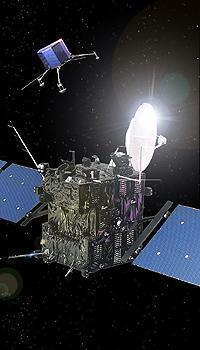
| This artist's impression shows the Rosetta Orbiter in the foreground and the Lander in the background.
|

|
|
 |
| LAUNCH DATE: |
02-Mar-2004 07:17 UT
|
| MISSION END: | End of mission (nominal)
- Perihelion passage - 2015.
|
| LAUNCH VEHICLE: | Ariane 5 G+ from Kourou, French Guiana. |
| LAUNCH MASS: | 3000 kg |
| MISSION PHASE: |
Spacecraft and Payload Commissioning |
|
Rosetta has a complex trajectory which includes four gravity assist manoeuvres (3 x Earth, 1 x Mars) before finally reaching the comet. On arrival at 67P Rosetta will enter orbit around the comet and stay with it as it journeys in towards the Sun. |
To study the origin of comets, the relationship between cometary and interstellar material, and its implications with regard to the origin of the Solar System. The measurements to be made to achieve this are:
- Global characterisation of the nucleus, determination of dynamic properties, surface morphology and composition;
- Determination of the chemical, mineralogical and isotopic compositions of volatiles and refractories in a cometary nucleus;
- Determination of the physical properties and interrelation of volatiles and refractories in a cometary nucleus;
- Study of the development of cometary activity and the processes in the surface layer of the nucleus and the inner coma (dust/gas interaction);
- Global characterisation of asteroids, including determination of dynamic properties, surface morphology and composition.
|
|

